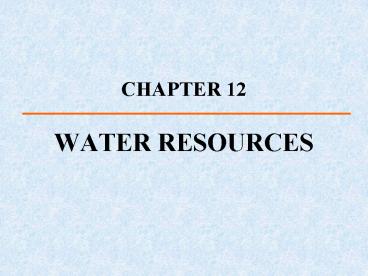WATER RESOURCES PowerPoint PPT Presentation
1 / 34
Title: WATER RESOURCES
1
WATER RESOURCES
2
Case History Long Island
- GW pollution 1900 from agriculture
- GW decline
- Salt water intrusion
- Urbanization triggered more serious water
pollution
3
Management options
4
Reduce urban runoff?
5
Global Water Cycle
- Cyclic nature
- Global movementof water between different water
reservoirs - Global distribution
- Abundance not a problem
- Distribution in space and over time a problem
- Supply vs. use a problem
6
Global Water Cycle
- Waters vertical movement
- Upflow Evaporation, transpiration
- Downflow Precipitation and infiltration
- Waters horizontal movement
- Surface runoff
- Shallow subsurface flow
- Groundwater flow
7
Water, water, everywhere
- Mostly (97) seawater salty
- Remainder mostly (75) ice solid
- Remainder mostly (67) groundwater-hidden
8
The Hydrologic Cycle
- Reservoirs and fluxes (as )
9
Surface Water
- Surface runoff
- Drainage network
- Drainage basin or watershed
- Drainage divide
- Stream order and size of drainage basin
- Sediment pollution(?)
10
Groundwater Layers
- Groundwater (GW) profile
- Vadose zone (unsaturated zone, zone of aeration)
- Phreatic zone (zone of saturation)
- Water table The boundary of the above two zones
11
Groundwater definitions
12
Groundwater recharge and discharge
- Recharge zone Area where water infiltrates
downward from surface to GW - Discharge zone Area where GW is removed from an
aquifer, such as spring, well, river, etc. - Influent stream above the water table, recharge
water to GW, may be intermittent Losing - Effluent stream perennial stream with the
addition of GW when precipitation is low Gaining
13
Visualizing Groundwater
- Aquifer
- Aquitard/ aquiclude
- Confined/ unconfined aquifer
- Water table
- Perched aquifer
Layer-cake
Sponge
Losing
Gaining
14
Groundwater (5)
- GW pressure surface/water table
- Generally declining from source along the flow
from recharge area to discharge area - True for unconfined (water table) and confined
aquifers - Artesian well Water self-rising above the land
surface(?) from a confined aquifer punctured by
a well - Cone of depression Drawdown cone of GW in a well
15
Artesian wells
- Wells in which water rises without pumping are
artesian - Those that flow are called flowing artesian
- Requires confined aquifer
- Water rises towards potentiometric surface
16
Water Table Issues
- Drawdown
- Vertical
- Cone of Depression
- 3-D
- Dewatering
- Overlap
- Pollution
- Change of gradient
17
Groundwater Movement (1)
- Hydraulic gradient The gradient of water table,
generally following the topographic gradient - The water table is subparallel to the ground
surface. - Hydraulic conductivity Ability of rock materials
to allow water to move through (m3/day/m2) - Porosity Percentage of void (empty) space in
sediment or rock to store water - Permeability Measuring the interconnection of
pores in a rock material
18
Groundwater
- Aquifers
- Porosity
- f(size, sorting)
- Permeability
- f(sorting, cement)
19
Groundwater Movement (2)
20
Groundwater Use and Supply (1)
- Available GW estimated above the total flow of
the Mississippi during the last 200 years - GW is primary drinking water source for 50 of
the U.S. population
21
(No Transcript)
22
Groundwater Use and Supply (2)
- Problems
- Overdrafts
- Pollution (later)
Figure 12.13
23
Water Uses (1)
- Offstream use Removal or diversion from its SW
or GW sources temporarily, e.g., irrigation,
thermoelectric, industrial use - Consumptive use Type of offstream use of water
without intermediate return to the SW or GW, such
as transpiration and human use - Instream use Navigation, fish and wildlife,
recreational uses - Water law
- Riparian (you touch it, you use it)
- Appropriation (first in time first in right)
24
Water Use (2)
- In major urban areas
- Overwithdrawal of groundwater
- Overuse of local surface water
- Threats of local urban landfills to the water
supply, e.g., Long Island, NY - Water import issues and problems
- What is distance to transport?
- How much water available?
- From where? Conflicts with other areas,
litigations, and long-range planning
25
Trends in Water Use (2)
- So what do we do about it?
- Environmentalism
- Reduce
- Reuse
- Recycle
- New Environmentalism (Andy Posner, Huffington
Post, 8/03/08) - Invent
- Invest
- Implement
Figure 12.20
26
Water Management (1)
- Challenges for water management
- Increasing demand for water use (population and
economic development) - Water supply problems in semiarid and arid
regions - Water supply problems in megacities of humid
regions - Water traded as a commodity Capital, market, and
regulations?
27
Management of the Colorado River (1)
28
Significance of water
- Hoover Dam/Lake Mead
- Water to ImperialValley, LA
- Power to CA, AZ, NV
29
http//www.hcn.org/
30
Multipurpose Dam(n)s
- Irrigation 48
- Electricity generation 36
- Water supply 36
- Flood control 39
- Recreation/fisheries 29
- Inland navigation 5
31
Management of the Colorado River (2)
32
Water and Ecosystems
33
Emerging Global Water Shortage
34
Applied and Critical Thinking Topics

